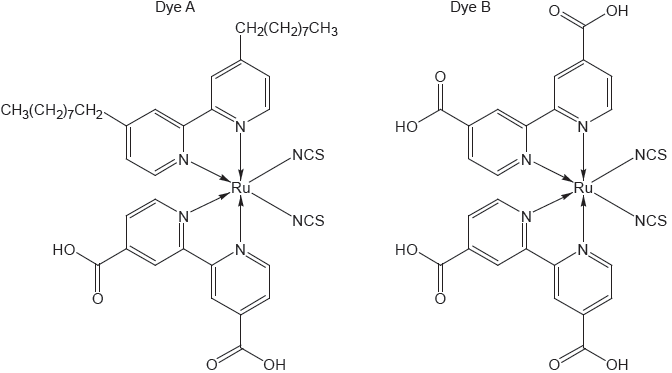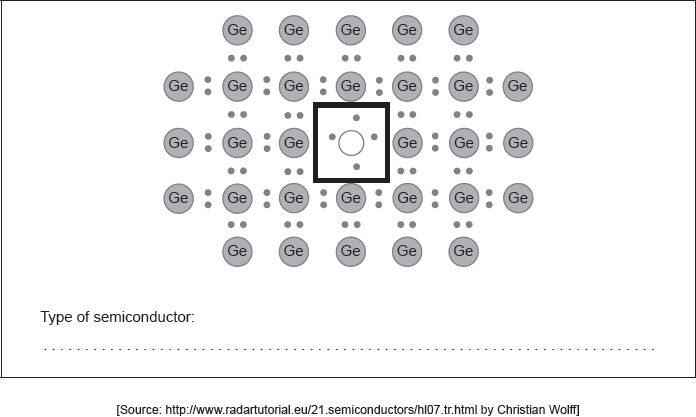DP Chemistry Questionbank

C.8 Photovoltaic and dye-sensitized solar cells (HL only)
Description
[N/A]Directly related questions
-
16N.3.hl.TZ0.21c:
Dye-sensitized solar cells (DSSC) convert solar energy into electrical energy.
(i) Describe how a DSSC converts sunlight into electrical energy.
(ii) Explain the role of the electrolyte solution containing iodide ions, I−, and triiodide ions, I3−, in the DSSC.
-
17M.3.hl.TZ1.19b:
Both photosynthesis and the Grätzel cell use energy from sunlight to bring about reduction. Deduce an equation for the reduction reaction in the electrolyte of a Grätzel cell.
-
17M.3.hl.TZ1.19a:
Identify two ways in which the structure of the dye shown resembles the chlorophyll molecule. Use section 35 of the data booklet.
-
17M.3.hl.TZ2.19b:
Suggest one advantage a DSSC has over a silicon based photovoltaic cell.
-
17M.3.hl.TZ2.19a:
Contrast how absorption of photons and charge separation occur in each device.
-
17M.3.hl.TZ2.18a.ii:
The structures of 11-cis-retinal and β-carotene are given in section 35 of the data booklet. Suggest a possible wavelength of light absorbed by each molecule using section 3 of the data booklet.
- 20N.3.hl.TZ0.14b: Doping of silicon increases the conductivity in semiconductors. Explain how doping improves the...
-
20N.3.hl.TZ0.14a:
Doping of silicon increases the conductivity in semiconductors.
Describe the doping in p-type and n-type semiconductors.
-
17N.3.hl.TZ0.19b:
The natural absorption of light by chlorophyll has been copied by those developing dye-sensitized solar cells (DSSCs). Outline how a DSSC works.
-
18M.3.hl.TZ1.15b:
Dye-sensitized solar cells, DSSCs, use a dye to absorb the sunlight. State two advantages that DSSCs have over traditional silicon based photovoltaic cells.
-
18M.3.hl.TZ1.15a:
Early photovoltaic cells were based on silicon containing traces of other elements. State the type of semiconductor produced by doping silicon with indium, In, giving a reason that refers to its electronic structure.
-
18M.3.hl.TZ1.15c:
The structure of two dyes used in DSSCs are shown.

Predict, giving a reason, which dye will absorb light of longer wavelength.
-
18M.3.hl.TZ2.18a:
Draw the Lewis (electron dot) structure for an appropriate doping element in the box in the centre identifying the type of semiconductor formed.

-
18M.3.hl.TZ2.18b.ii:
Outline why complex B absorbs light of longer wavelength than complex A.
-
18M.3.hl.TZ2.18b.i:
State the feature of the molecules responsible for the absorption of light.
-
18N.3.hl.TZ0.15d.iv:
Deduce the reduction half-equation at the cathode.
- 18N.3.hl.TZ0.15d.ii: Outline the effect of sunlight on the dye in the solar cell.
- 18N.3.hl.TZ0.15d.i: Identify the structural feature of the dye that allows the conversion of solar energy into...
- 18N.3.hl.TZ0.15d.iii: State the purpose of TiO2.
-
19M.3.hl.TZ1.18a:
Some solar cells use photovoltaic semi-conductors. Compare, giving reasons, the electrical conductivity of metals and semi-conductors as temperature increases.
-
19M.3.hl.TZ1.18b:
Suggest one advantage of a dye-sensitized solar cell (DSSC) over a silicon based photovoltaic cell.
-
19M.3.hl.TZ2.20a:
Sketch graphs to show the general effect of increasing temperature on the electrical conductivity of semiconductors and metals on the axes below.
-
19M.3.hl.TZ2.20b:
Explain the function of dyes in a dye-sensitized solar cell (DSSC).
- 19N.3.hl.TZ0.20d(i): Outline the functions of the dye, TiO2 and the electrolyte in the operation of the...
- 19N.3.hl.TZ0.20d(ii): Suggest an advantage of the DSSC over silicon-based photovoltaic cells.
